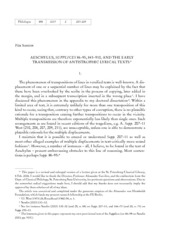| dc.contributor.author | Sandin, Pär Ola | eng |
| dc.date.accessioned | 2010-04-16T11:03:34Z | |
| dc.date.available | 2010-04-16T11:03:34Z | |
| dc.date.issued | 2007 | eng |
| dc.Published | Philologus (151): 207-229 | en |
| dc.identifier.issn | 0031-7985 | |
| dc.identifier.other | oai:frida.no:493607 | eng |
| dc.identifier.uri | https://hdl.handle.net/1956/3880 | |
| dc.description.abstract | The symmetrical inter-displacements of corresponding blocks of text between strophes and antistrophes in lyrical odes, earlier proposed for A. Supp. 88–90 ~ 93–95, 872–75 ~ 882–84, and 906–7 ~ 909–10, have affected all parts sung or spoken by the Egyptian herald in the amoibaion in Supp. 843–910. An ancestral text similar to a modern musical score, in which the corresponding lines of strophe and antistrophe run parallel with musical notation, could explain this type of corruption. Such a hypothetical ancestor in the textual tradition would also explain apparent interpolations in Supp. 852 and 865 from 842 and 843. The corruptions may have arisen very early in the tradition, the hypothetical textual arrangement possibly being that of the author himself. | en_US |
| dc.language.iso | eng | eng |
| dc.publisher | Akademie Verlag | eng |
| dc.subject | Aeschylus | eng |
| dc.subject | Supplices | eng |
| dc.subject | Textual criticism | eng |
| dc.subject | Palaeography | eng |
| dc.title | Aeschylus, Supplices 86–95, 843–910, and the early transmission of antistrophic lyrical texts | eng |
| dc.type | Peer reviewed | |
| dc.type | Journal article | |
| dc.rights.holder | Copyright Akademie Verlag. All rights reserved. Reproduced with permission. | |
| dc.rights.holder | Akademie Verlag | eng |
| dc.subject.nsi | VDP::Humaniora: 000::Språkvitenskapelige fag: 010::Klassisk filologi: 032 | |
